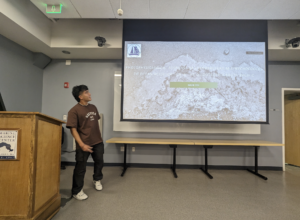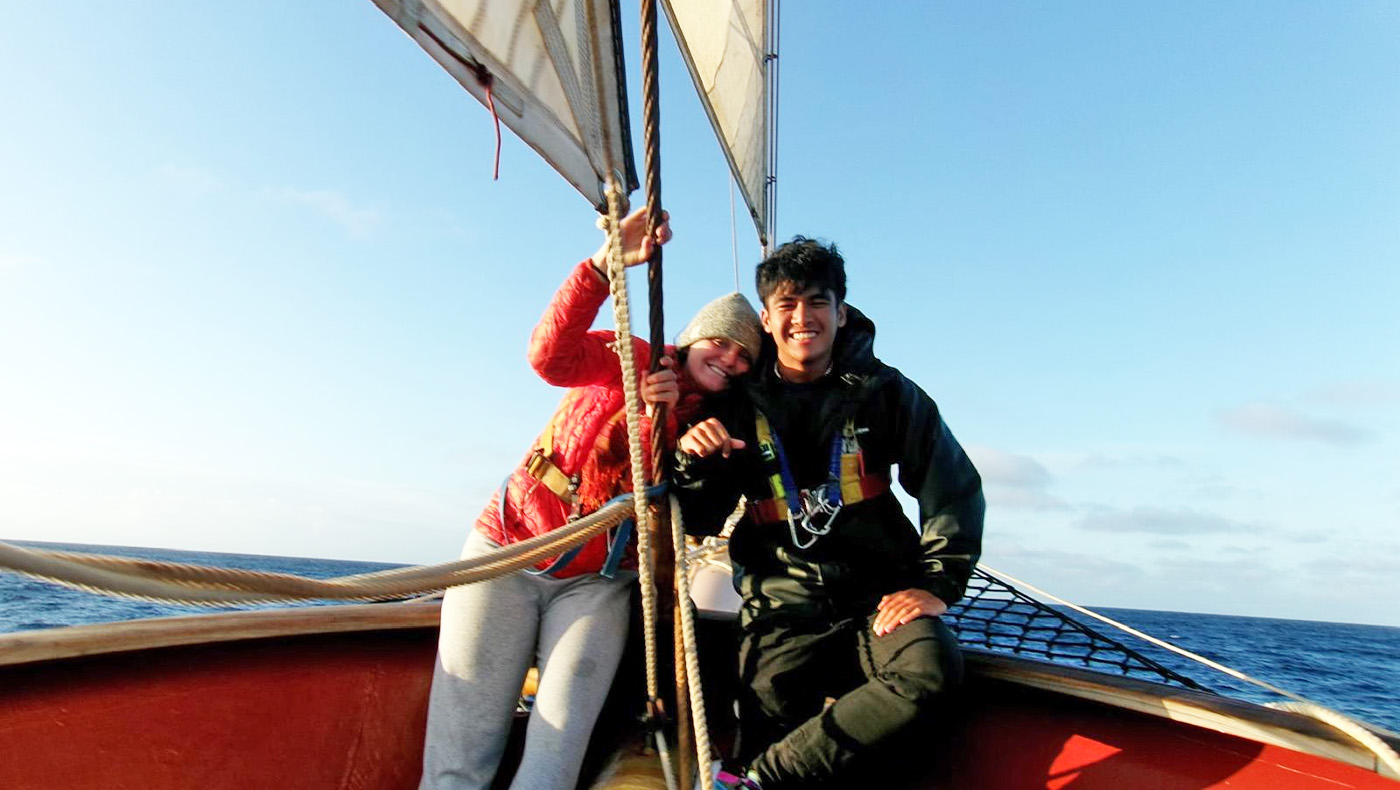Undergraduate researchers are an integral part of the Marine and Environmental Sciences department and significant contributors to our labs’ scientific advancement. We caught up with undergraduate student Mark Teh to chat about his exciting research endeavors both within the MES department and with external partners.

Q: Can you tell me a little bit about yourself, your interests, and your goals?
My name is Mark Teh and I am currently a sophomore in Northeastern’s Honors Program majoring in Biochemistry with minors in Environmental Engineering and Materials Science. While my academic interests range from synthetic biology to oceanography, my overarching passion lies in the development of biologically-inspired approaches for addressing modern climate-related concerns.
You will often find me working in the lab, but beyond academics, I share a great appreciation for sports. Soccer was my primary pursuit growing up, and you can still find me enjoying intramural soccer sessions with my friends. I am also an avid runner, and recently delved into ultramarathons, having finished a 50-kilometre trail race in the Oregon mountains last summer. Passionate about leading a socially impactful career, I have recently joined Engineers Without Borders as Team Uganda’s grant writing lead where I hope to put my experience in academic writing to good use whilst gaining an experiential education alongside like-minded peers.
Q: What interested you about Dr. Ries’ research and inspired you to get involved?
While I spent a good portion of my childhood moving around the world – Malaysia, China, USA, and Singapore – I had always been based in the heart of cities. Given these inherently business-centric urban environments, aspiring scientists were few and far between. Therefore, most of my inspiration came from obsessing over shows on National Geographic and the Discovery Channel, through which I learned about the structural complexities and biochemical diversity of the natural world. I always believed that there had to be a way for us to leverage these streamlined mechanisms to combat our planet’s most pressing issues.
Spending whatever free time I had consuming scientific literature, it was not long before I learned of the significance of calcium carbonate (CaCO3) in global carbon cycling. Serving as the ocean’s primary buffer against acidification and the fundamental building block of islands and atolls while simultaneously playing important roles in urban construction, it appeared that I had found the ideal platform to begin my research journey at the intersection between climate science and engineering. With regards to Dr. Ries’ work, what stood out to me was not only his work on geologically-inspired methods of carbon sequestration, that aligned greatly with my interest in the applied sciences, but also his research on the mixed responses of marine calcifiers to ocean acidification – it blew my mind that ocean acidification was not ubiquitously deleterious!
Q: Tell us more about the research you’ve been undertaking with Dr. Ries.
Following my first semester abroad on the NU.i.n. Greece program, I arrived at Northeastern’s Boston campus for the spring 2023 semester and met with Dr. Ries to discuss my interests and undergraduate aspirations. I was then trained in several analytical techniques before undertaking my first project in the lab.
This research project focused on investigating the large-scale distribution of calcium carbonate deposits on the northwestern Atlantic continental shelf, which have the capacity to chemically buffer anthropogenic elevations of atmospheric carbon dioxide, functioning as a global “pH-stat” of sorts. During the spring and summer of 2023, I had the opportunity to use box core sediment samples collected during NOAA’s 2022 East Coast Ocean Acidification (ECOA-3) research cruise to characterize the abundance and mineralogy of calcium carbonate deposits along transects crisscrossing the northwestern Atlantic continental shelf. As part of these analyses, we not only mapped the distributions of CaCO3 in shelf sediments, as well as their mineral phases (aragonite versus calcite), but also contrasted them with regional geochemical trends, such as pH, CaCO3 saturation state, and salinity. In support of this work, I was awarded a Grants-in-Aid of Research (GIAR) Award from the Sigma Xi Scientific Research Honor Society and Northeastern’s Marine Science Center (MSC) Undergraduate Summer Research Fellowship. At present, we are working on a manuscript presenting the project’s results, which we plan to submit to a peer-reviewed journal later this year.
Q: How did your recent Northeastern PEAK award contribute to your research?
Over summer 2023, I started work on another project with the Ries Lab and collaborators at MIT, focusing on investigating the large-scale electrochemical precipitation of carbon-capturing alkaline minerals from seawater. Having placed this research on hold while I studied abroad during the fall of 2023, I recently received funding via a Northeastern PEAK Base Camp Award to continue these research efforts. This has enabled me to gain invaluable experience in the more applied fields of electrochemistry and materials science and engineering through system fabrication, assembly, and mineralogical analyses, as I test a broad range of precipitation conditions to investigate the optimal physicochemical conditions for precipitating CO2-sequestering minerals from seawater
Q: What are some of your other research experiences?
Over the second half of summer 2023, I returned home to Singapore and worked with Dr. Patrick Martin’s lab at Nanyang Technological University, where I conducted preliminary photochemical experiments to validate the performance of a new photo-bio-degradation recirculation system. The primary objective of this project was to quantify the percent-contributions of photodegradation to the total breakdown of terrigenous dissolved organic matter, derived from the chemical weathering of rocks, in Southeast Asian water columns to better inform regional climate models.
After completing my summer research in Singapore, my fall 2023 study abroad involved an oceanographic research expedition from Fiji to New Zealand, with a notable port stop at the world’s least visited country – Tuvalu! During this 4,000 nautical mile journey, I conducted an independent investigation into the effects of ocean acidification on the abilities of oligotrophic Synechococcus cyanobacteria (blue-green algae) to adjust their photopigmentation in response to changes in the availability of photosynthetically active radiation (PAR)—a process dubbed photoacclimation. Supervised by Northeastern alumni Dr. Jan Witting from the Sea Education Association (SEA), this study was one of the first in situ investigations on the topic. My results not only contested prior in vivo findings on cyanobacterial photoacclimation, but also proposed a novel microbiological driver of increasingly frequent harmful algal blooms (HABs) in the region.
Q: What are your next steps as a research-active undergraduate?
Moving forward, I hope to leverage my fundamental understanding of microbiological and geochemical mechanisms to expand into more applied fields of research – hence, my current semester’s co-supervised PEAK project in electrochemistry and materials science.
Having developed an academic plan centered around intensive co-curricular research, I have also recently started work with Dr. Jing-Ke Weng’s synthetic biology and natural product biochemistry lab at Northeastern’s new Institute for Plant-Human Interface. While I am still learning the ropes as a new member of the group, the ultimate goal is to develop an understanding of how biosynthetic pathways can be experimentally elucidated and metabolically engineered for scalable commercial applications.
Q: Where will this experience take you?
In the near-future, I hope to draw upon my interdisciplinary research experiences to collaboratively develop biologically-inspired technologies that combat climate inequity by addressing the significant climate challenges faced by less economically developed regions of the world.
Looking further into the future, my academic plans entail pursuing a research-based Masters in the engineering sciences before undertaking a PhD in Biochemical Oceanography. Thereafter, I hope to become a professor and inspire the next generation of collaborative biocentric climate scientists and engineers, while simultaneously pursuing my entrepreneurial ambitions in the field of biotechnology-based climate solutions.

Photos provided by Mark Teh

